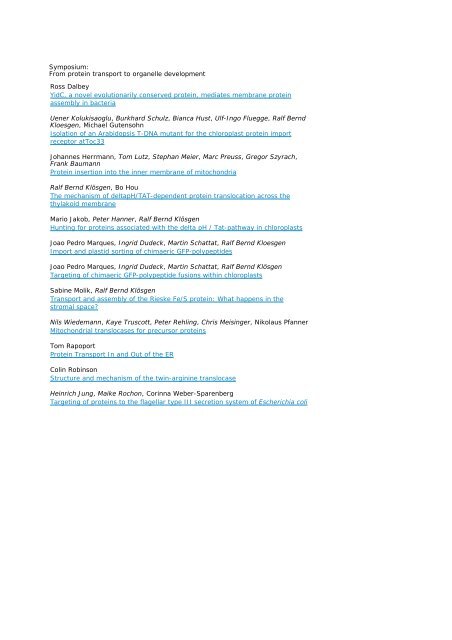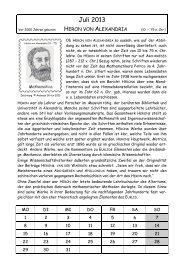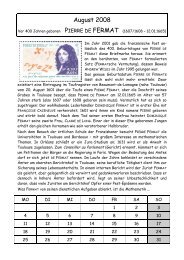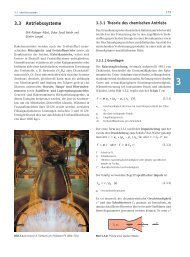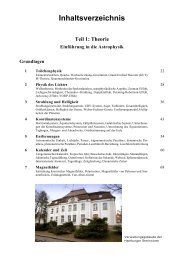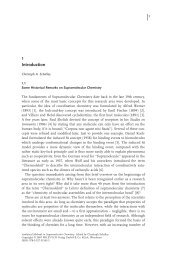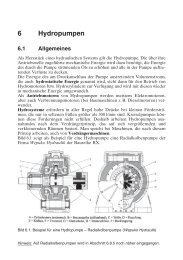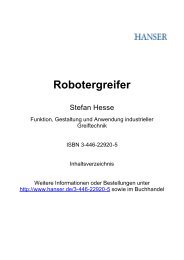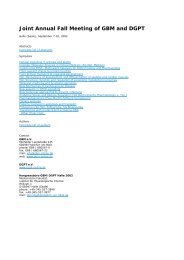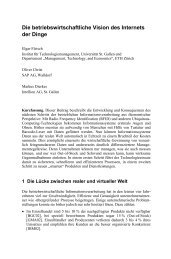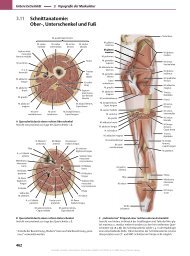From protein transport to organelle development
From protein transport to organelle development
From protein transport to organelle development
You also want an ePaper? Increase the reach of your titles
YUMPU automatically turns print PDFs into web optimized ePapers that Google loves.
Symposium:<br />
<strong>From</strong> <strong>protein</strong> <strong>transport</strong> <strong>to</strong> <strong>organelle</strong> <strong>development</strong><br />
Ross Dalbey<br />
YidC, a novel evolutionarily conserved <strong>protein</strong>, mediates membrane <strong>protein</strong><br />
assembly in bacteria<br />
Uener Kolukisaoglu, Burkhard Schulz, Bianca Hust, Ulf-Ingo Fluegge, Ralf Bernd<br />
Kloesgen, Michael Gutensohn<br />
Isolation of an Arabidopsis T-DNA mutant for the chloroplast <strong>protein</strong> import<br />
recep<strong>to</strong>r atToc33<br />
Johannes Herrmann, Tom Lutz, Stephan Meier, Marc Preuss, Gregor Szyrach,<br />
Frank Baumann<br />
Protein insertion in<strong>to</strong> the inner membrane of mi<strong>to</strong>chondria<br />
Ralf Bernd Klösgen, Bo Hou<br />
The mechanism of deltapH/TAT-dependent <strong>protein</strong> translocation across the<br />
thylakoid membrane<br />
Mario Jakob, Peter Hanner, Ralf Bernd Klösgen<br />
Hunting for <strong>protein</strong>s associated with the delta pH / Tat-pathway in chloroplasts<br />
Joao Pedro Marques, Ingrid Dudeck, Martin Schattat, Ralf Bernd Kloesgen<br />
Import and plastid sorting of chimaeric GFP-polypeptides<br />
Joao Pedro Marques, Ingrid Dudeck, Martin Schattat, Ralf Bernd Klösgen<br />
Targeting of chimaeric GFP-polypeptide fusions within chloroplasts<br />
Sabine Molik, Ralf Bernd Klösgen<br />
Transport and assembly of the Rieske Fe/S <strong>protein</strong>: What happens in the<br />
stromal space?<br />
Nils Wiedemann, Kaye Truscott, Peter Rehling, Chris Meisinger, Nikolaus Pfanner<br />
Mi<strong>to</strong>chondrial translocases for precursor <strong>protein</strong>s<br />
Tom Rapoport<br />
Protein Transport In and Out of the ER<br />
Colin Robinson<br />
Structure and mechanism of the twin-arginine translocase<br />
Heinrich Jung, Maike Rochon, Corinna Weber-Sparenberg<br />
Targeting of <strong>protein</strong>s <strong>to</strong> the flagellar type III secretion system of Escherichia coli
Ross Dalbey<br />
YidC, a novel evolutionarily conserved <strong>protein</strong>, mediates membrane <strong>protein</strong><br />
assembly in bacteria<br />
Membranes contain <strong>protein</strong>s that catalyze a variety of reactions, which lead <strong>to</strong><br />
the selective permeability of the membrane. For membrane <strong>protein</strong>s <strong>to</strong> function<br />
as recep<strong>to</strong>rs, <strong>transport</strong>ers, channels, and ATPases, they must be targeted <strong>to</strong> their<br />
correct membrane and inserted in<strong>to</strong> the lipid bilayer. Our goal is <strong>to</strong> understand<br />
the biogenesis of poly<strong>to</strong>pic membrane <strong>protein</strong>s in bacteria. While most E. coli<br />
membrane <strong>protein</strong>s use the Sec YEG pathway for insertion in<strong>to</strong> the plasma<br />
membrane, there are some <strong>protein</strong>s that insert independent of the Sec pathway.<br />
Recently we identified a new membrane component called YidC that is essential<br />
for insertion of these Sec-independent <strong>protein</strong>s. YidC is essential for cell viability<br />
and is found in mi<strong>to</strong>chondria and chloroplasts. Depletion of YidC interferes also<br />
with the insertion of Sec-dependent membrane <strong>protein</strong>s. We find that YidC<br />
directly interacts with membrane <strong>protein</strong>s during the process of membrane<br />
<strong>protein</strong> insertion. The chloroplast homolog Albino3 can functionally complement<br />
the bacterial YidC depletion strain, demonstrating that the chloropast and<br />
bacterial YidC homologs are truly functional homologs. The function of YidC for<br />
Sec-independent <strong>protein</strong>s may be analogous <strong>to</strong> a chaperone because YidC has<br />
been shown <strong>to</strong> bind and fold the inserting membrane <strong>protein</strong>s and not <strong>to</strong> interact<br />
with the fully synthesized and assembled <strong>protein</strong>. For sec-dependent <strong>protein</strong>s,<br />
YidC is proposed <strong>to</strong> catalyze the movement of hydrophobic regions out of the Sec<br />
channel and in<strong>to</strong> the lipid bilayer.<br />
contact:<br />
Professor Ross Dalbey<br />
Ohio State University<br />
Department of Chemistry<br />
dalbey@chemistry.ohio-state.edu<br />
100 West 18th Ave<br />
43210 Columbus,OH (USA)
Uener Kolukisaoglu, Burkhard Schulz, Bianca Hust, Ulf-Ingo Fluegge, Ralf Bernd<br />
Kloesgen, Michael Gutensohn<br />
Isolation of an Arabidopsis T-DNA mutant for the chloroplast <strong>protein</strong> import<br />
recep<strong>to</strong>r atToc33<br />
A great number of plastid <strong>protein</strong>s are nuclear encoded, are synthesized in the<br />
cy<strong>to</strong>sol as precursor with a N-terminal extension (transitpeptide) and have <strong>to</strong> be<br />
imported in<strong>to</strong> the <strong>organelle</strong> posttranslationally. Two <strong>protein</strong> complexes located in<br />
the plastidic envelope membranes are responsible for this <strong>transport</strong> process. One<br />
of the first steps of this <strong>transport</strong> is the binding of the precursor <strong>protein</strong> with its<br />
transitpeptide <strong>to</strong> one or several recep<strong>to</strong>r <strong>protein</strong>s, that are exposed on the<br />
cy<strong>to</strong>solic surface of the plastids. Toc34, a GTP binding component of the import<br />
complex in the outer chloroplast envelope, is one of these recep<strong>to</strong>rs and was<br />
shown <strong>to</strong> directly interact with precursor <strong>protein</strong>s. To gain more insight in<strong>to</strong> the<br />
in vivo function of this recep<strong>to</strong>r a reverse genetic approach was taken. A<br />
collection of about 32000 Arabidopsis T-DNA lines was sucessfully screened for<br />
insertions in the atToc33 gene, one of the two Arabidopsis Toc34 homologues.<br />
The T-DNA insertion in the isolated mutant is located in the promo<strong>to</strong>r region of<br />
the atToc33 gene. The atToc33 mutant shows a pale yellowish phenotype, that<br />
has also been observed after antisense repression of atToc33, and could be<br />
complemented upon transformation with the wildtype cDNA. Further molecular<br />
and physiological characterisation of the mutant will be presented.<br />
contact:<br />
Dr. Michael Gutensohn<br />
MLU Halle-Wittenberg<br />
Institut für Pflanzenphysiologie<br />
gutensohn@pflanzenphys.uni-halle.de<br />
Weinbergweg 10<br />
06120 Halle/ Saale (Deutschland)
Johannes Herrmann, Tom Lutz, Stephan Meier, Marc Preuss, Gregor Szyrach,<br />
Frank Baumann<br />
Protein insertion in<strong>to</strong> the inner membrane of mi<strong>to</strong>chondria<br />
The inner membrane of mi<strong>to</strong>chondria contains a large number and variety of<br />
<strong>protein</strong>s. Most of these <strong>protein</strong>s are synthesized in the cy<strong>to</strong>plasm and imported<br />
in<strong>to</strong> mi<strong>to</strong>chondria. Inner membrane <strong>protein</strong>s are inserted on different sorting<br />
pathways. Mono<strong>to</strong>pic <strong>protein</strong>s can be inserted following a translocation arrest at<br />
the level of the inner membrane. An insertion route from the intermembrane<br />
space is also used by poly<strong>to</strong>pic <strong>protein</strong>s which have not evolved from bacterial<br />
homologues. In contrast, we found that poly<strong>to</strong>pic <strong>protein</strong>s derived from the<br />
endosymbiotic ances<strong>to</strong>rs of mi<strong>to</strong>chondria are first completely imported in<strong>to</strong> the<br />
mi<strong>to</strong>chondrial matrix and subsequently inserted in<strong>to</strong> the membrane. This<br />
insertion process depends on the membrane potential and resembles the<br />
insertion of membrane <strong>protein</strong>s in bacteria in several respects.<br />
The same insertion route is used by inner membrane <strong>protein</strong>s that are<br />
synthesized on mi<strong>to</strong>chondrial ribosomes. Membrane integration of these <strong>protein</strong>s<br />
depends on the Oxa1 <strong>protein</strong>, a component related <strong>to</strong> bacterial YidC. Oxa1 forms<br />
an oligomeric complex in the inner membrane and contains a matrix-exposed<br />
domain which has the ability <strong>to</strong> bind translating mi<strong>to</strong>chondrial ribosomes and is<br />
required for efficient insertion of nascent polypeptides. This suggests that<br />
cotranslational membrane insertion of mi<strong>to</strong>chondrial translation products is<br />
achieved by a physical contact of translation complexes with the OXA translocase<br />
in the inner membrane.<br />
contact:<br />
Dr. Johannes Herrmann<br />
Universität München<br />
Institut für Physiologische Chemie<br />
hannes.herrmann@bio.med.uni-muenchen.de<br />
Butenandtstrasse 5<br />
81377 München (Germany)
Ralf Bernd Klösgen, Bo Hou<br />
The mechanism of deltapH/TAT-dependent <strong>protein</strong> translocation across the<br />
thylakoid membrane<br />
Protein translocation in<strong>to</strong> or across the thylakoid membrane is accomplished by<br />
at least four distinct pathways: the Sec-dependent pathway, the SRP-dependent<br />
pathway, the pH/TAT-dependent pathway and the spontaneous <strong>protein</strong><br />
insertion pathway. The pH/TAT-dependent <strong>protein</strong> translocation pathway is the<br />
sole system that is capable of <strong>transport</strong>ing both folded and unfolded <strong>protein</strong>s<br />
across the thylakoid membrane. Translocation of precursors by this pathway<br />
does not need stromal fac<strong>to</strong>rs or nucleoside triphosphates, but is strictly<br />
dependent on the thylakoidal pH. In order <strong>to</strong> analyze the mechanism of<br />
pH/TAT-dependent <strong>protein</strong> translocation, we have constructed a chimeric 16/23<br />
<strong>protein</strong>, which consists of the transit peptide of the 16 kDa <strong>protein</strong> and the<br />
mature part of the 23 kDa <strong>protein</strong>. Like the two corresponding authentic<br />
precursor <strong>protein</strong>s (pre-16 kDa and pre-23 kDa, respectively), the chimeric<br />
16/23 is targeted by pH/TAT-dependent pathway. During thylakoid import, the<br />
chimeric <strong>protein</strong> is retarded in the pH/TAT-dependent translocation machinery,<br />
resulting in transmembrane translocation intermediates. Two distinct steps of the<br />
<strong>transport</strong> process have been identified, which are characterized by different<br />
<strong>to</strong>pologies of the translocation intermediates. Taking advantage of this finding,<br />
we could make detailed studies on the mechanism of each processing step. Data<br />
on the differences between these two steps, e.g. considering their dependence<br />
upon pH/TAT-translocase or the energy requirement, will be presented.<br />
contact:<br />
Master Bo Hou<br />
Martin-Luther-Universität Halle-Wittenberg<br />
Institut für Pflazenphysiologie<br />
hou@pflanzenphys.uni-halle.de<br />
Weibergweg 10<br />
06120 Halle (Saale) (Germany)
Mario Jakob, Peter Hanner, Ralf Bernd Klösgen<br />
Hunting for <strong>protein</strong>s associated with the delta pH / Tat-pathway in chloroplasts<br />
Among the four <strong>protein</strong> <strong>transport</strong> pathways which have been identified at the<br />
thylakoid membrane of chloroplasts, the delta pH/Tat-pathway is of particular<br />
interest because of its unusual mechanism: it does not require soluble fac<strong>to</strong>rs nor<br />
nucleoside triphosphates but depends strictly and exclusively on the pro<strong>to</strong>n<br />
gradient that is generated during pho<strong>to</strong>synthesis across the thylakoid membrane.<br />
Furthermore, like its bacterial counterpart it is able <strong>to</strong> <strong>transport</strong> folded<br />
polypeptide chains. Three components of the thylakoidal delta pH/Tat-<strong>transport</strong><br />
machinery have been identified so far (Tat A, B, C). During <strong>transport</strong> of a <strong>protein</strong><br />
across the thylakoid membrane, these subunits apparently form multimeric<br />
complexes of approximately 560 kDa and 620 kDa.<br />
The goal of the project is <strong>to</strong> find out whether Tat A, B, and C interact<br />
permanently with each other in the thylakoid membrane, or whether they<br />
assemble in<strong>to</strong> a common complex only during the actual <strong>transport</strong> process.<br />
Furthermore, we want <strong>to</strong> examine whether additional thylakoidal <strong>protein</strong>s which<br />
would be promising candidates for peripheral and/or modulating components of<br />
the thylakoidal Tat-translocase can be found attached <strong>to</strong> Tat A, B, or C,<br />
respectively. For this purpose, antibodies specifically recognizing either of the<br />
three Tat-components were immobilized by various methods and used for affinity<br />
chroma<strong>to</strong>graphy of solubilized thylakoid preparations from Arabidopsis thaliana.<br />
Stepwise elution pro<strong>to</strong>cols were developed in order <strong>to</strong> separate potential binding<br />
partners with different degrees of binding affinity. Subsequent analysis by<br />
MALDI-TOF mass spectrometry is performed in order <strong>to</strong> characterize the<br />
interacting <strong>protein</strong>s. First results of this approach will be presented.<br />
contact:<br />
Dr. Mario Jakob<br />
Martin-Luther-Universität Halle-Wittenberg<br />
Pflanzenphysiologie<br />
jakob@pflanzenphys.uni-halle.de<br />
Weinbergweg 10<br />
06120 Halle (Deutschland)
Joao Pedro Marques, Ingrid Dudeck, Martin Schattat, Ralf Bernd Kloesgen<br />
Import and plastid sorting of chimaeric GFP-polypeptides<br />
In order <strong>to</strong> get further insights in<strong>to</strong> the <strong>transport</strong> specificity of the different<br />
thylakoid import pathways we have performed in vitro import experiments using<br />
<strong>protein</strong> fusions among the GFP <strong>protein</strong> and several thylakoid transit peptides. The<br />
later were part of <strong>protein</strong>s assigned <strong>to</strong> both the delta pH/TAT (16 and 23 kDa<br />
subunits of the water splicing complex of PS2) and Sec pathways (plas<strong>to</strong>cyanin<br />
and 33 kDa subunit of the water splicing complex of PS2).<br />
In the presence of isolated pea thylakoids we were able <strong>to</strong> demonstrate the<br />
efficient and specific targeting of 16/GFP and 23/GFP fusion <strong>protein</strong>s by the ?pH<br />
pathway <strong>to</strong> the thylakoid lumen. In contrast, even after the addition of isolated<br />
stroma fraction, no lumenal import of the PC/GFP and 33/GFP could be observed<br />
in isolated pea thylakoids. In the presence of intact pea and spinach chloroplasts,<br />
however, besides an efficient import of the 16/GFP and 23/GFP fusions, a low<br />
level of 33/GFP import in<strong>to</strong> the thylakoid lumen could also be detected.<br />
The data obtained suggest a preferential import of GFP fusions in<strong>to</strong> the thylakoid<br />
lumen via the delta pH pathway. The explanation for this behaviour might reside<br />
in the <strong>transport</strong> specificity of the delta pH pathway for folded <strong>protein</strong>s. In order<br />
<strong>to</strong> assay the folding status of GFP during the course of plastid import and internal<br />
sorting, transgenic Arabidopsis lines expressing GFP fusions are currently being<br />
produced.<br />
contact:<br />
Dok<strong>to</strong>r Joao Pedro Marques<br />
Martin-Luther-Universitat Halle<br />
Institut für Pflanzenphysiologie<br />
marques@pflanzenphys.uni-halle.de<br />
Weinbergweg 10<br />
06120 Halle (Saale) (Germany)
Joao Pedro Marques, Ingrid Dudeck, Martin Schattat, Ralf Bernd Klösgen<br />
Targeting of chimaeric GFP-polypeptide fusions within chloroplasts<br />
In order <strong>to</strong> get further insights in<strong>to</strong> the <strong>transport</strong> specificity of the different<br />
thylakoid import pathways, we have performed in vitro import experiments using<br />
<strong>protein</strong> fusions among the GFP <strong>protein</strong> and several thylakoid transit peptides. The<br />
later were part of <strong>protein</strong>s assigned <strong>to</strong> both the delta pH/TAT (16 and 23 kDa<br />
subunits of the water splicing complex of PS2) and Sec pathways (plas<strong>to</strong>cyanin<br />
and 33 kDa subunit of the water splicing complex of PS2).<br />
In the presence of isolated pea thylakoids we were able <strong>to</strong> demonstrate the<br />
efficient and specific targeting of 16/GFP and 23/GFP fusion <strong>protein</strong>s by the delta<br />
pH pathway <strong>to</strong> the thylakoid lumen. In contrast, even after the addition of<br />
isolated stroma fraction, no lumenal import of the PC/GFP and 33/GFP could be<br />
observed in isolated pea thylakoids. In the presence of intact pea and spinach<br />
chloroplasts, however, besides an efficient import of the 16/GFP and 23/GFP<br />
fusions, a low level of 33/GFP import in<strong>to</strong> the thylakoid lumen could also be<br />
noticed.<br />
The data obtained suggest a preferential import of GFP fusions in<strong>to</strong> the thylakoid<br />
lumen via the delta pH pathway. The explanation for this behaviour might reside<br />
in the <strong>transport</strong> specificity of the delta pH pathway for folded <strong>protein</strong>s. In order<br />
<strong>to</strong> assay the folding status of GFP during the course of plastid import and internal<br />
sorting, transgenic Arabidopsis lines expressing GFP fusions are currently being<br />
produced.<br />
contact:<br />
Dok<strong>to</strong>r Joao Pedro Marques<br />
MLU-Halle<br />
Institut für Pflanzenphysiologie<br />
marques@pflanzenphys.uni-halle.de<br />
Weinbergweg 10<br />
06120 Halle (Saale) (Germany)
Sabine Molik, Ralf Bernd Klösgen<br />
Transport and assembly of the Rieske Fe/S <strong>protein</strong>: What happens in the stromal<br />
space?<br />
The Rieske Fe/S <strong>protein</strong> is a nuclear-encoded subunit of the cy<strong>to</strong>chrom b6/f<br />
complex in chloroplasts. It is synthesised in the cy<strong>to</strong>sol as a precursor molecule<br />
with an N-terminal transit peptide, post-translationally <strong>transport</strong>ed in<strong>to</strong> the<br />
<strong>organelle</strong> and subsequently targeted via the delta pH/TAT pathway <strong>to</strong> the<br />
thylakoids. In contrast <strong>to</strong> all other thylakoid <strong>protein</strong>s analysed so far, <strong>transport</strong> of<br />
the Rieske <strong>protein</strong> is retarded in the stromal space leading <strong>to</strong> the accumulation of<br />
the <strong>protein</strong> in several complexes of high molecular weight. Using various chimeric<br />
and mutant Rieske <strong>protein</strong>s, complexes interacting specifically with either the<br />
hydrophilic lumenal domain or the thylakoid targeting signal which is provided by<br />
the membrane anchor can be distinguished. Among the latter is the cpn60<br />
system, the well known folding machinery in the chloroplast. Other stromal<br />
complexes might be responsible for Fe/S cofac<strong>to</strong>r insertion, because delta<br />
pH/TAT pathway is capable of <strong>transport</strong>ing folded <strong>protein</strong>s. In the case of the<br />
Rieske <strong>protein</strong>, correct folding and/or assembly of the iron-sufur cluster seems<br />
even <strong>to</strong> be a prerequisite for translocation across the thylakoid membrane.<br />
contact:<br />
Sabine Molik<br />
Martin-Luther-Universität Halle-Wittenberg<br />
Institut für Pflanzenphysiologie<br />
molik@pflanzenphys.uni-halle.de<br />
Weinbergweg 10<br />
06120 Halle (Saale) (Germany)
Nils Wiedemann, Kaye Truscott, Peter Rehling, Chris Meisinger, Nikolaus<br />
Pfanner<br />
Mi<strong>to</strong>chondrial translocases for precursor <strong>protein</strong>s<br />
Mi<strong>to</strong>chondria import hundreds of different <strong>protein</strong>s from the cy<strong>to</strong>sol. Three major<br />
translocase complexes have been identified in the mi<strong>to</strong>chondrial membranes. The<br />
translocase of the outer membrane (TOM complex) <strong>transport</strong> all kinds of<br />
precursor <strong>protein</strong>s. It consists of three recep<strong>to</strong>r <strong>protein</strong>s, a general import pore<br />
and assembly fac<strong>to</strong>rs. The inner membrane contains two translocases. The<br />
presequence translocase (TIM23 complex) <strong>transport</strong>s pre<strong>protein</strong>s with<br />
amino-terminal signal sequences (presequences), while the carrier translocase<br />
(TIM22 complex) is responsible for insertion of poly<strong>to</strong>pic membrane <strong>protein</strong>s with<br />
multiple internal targeting signals. All Tom and Tim <strong>protein</strong>s themselves are<br />
encoded by nuclear genes and synthesized as precursor <strong>protein</strong>s in the cy<strong>to</strong>sol.<br />
The precursors must be imported in<strong>to</strong> mi<strong>to</strong>chondria and assembled in<strong>to</strong><br />
functional translocase complexes.<br />
Literature<br />
Pfanner, N., and Geissler, A. (2001). Versatility of the mi<strong>to</strong>chondrial <strong>protein</strong><br />
import machinery. Nature Rev. Mol. Cell Biol. 2, 339-349<br />
contact:<br />
Prof. Nikolaus Pfanner<br />
Universität Freiburg<br />
Institut für Biochemie und Molekularbiologie<br />
Nikolaus.Pfanner@biochemie.uni-freiburg.de<br />
Hermann-Herder-Straße 7<br />
79104 Freiburg (D)
Tom Rapoport<br />
Protein Transport In and Out of the ER<br />
Protein <strong>transport</strong> across the ER membrane occurs through a <strong>protein</strong>-conducting<br />
channel formed from the heterotrimeric Sec61p complex. The channel itself is<br />
passive; it needs <strong>to</strong> associate with partners that provide the driving force for<br />
translocation and determine directionality. Translocation in<strong>to</strong> the ER can occur<br />
co- or post-translationally. Recent structural studies have given us a better view<br />
of the channel and how it connects with the ribosome during co-translational<br />
translocation. Proteins can also be translocated from the ER back in<strong>to</strong> the cy<strong>to</strong>sol<br />
(retro-translocation). To study the first steps in retro-translocation we have used<br />
cholera <strong>to</strong>xin. We have found that <strong>protein</strong> disulfide isomerase (PDI) in the ER<br />
lumen disassembles and unfolds the <strong>to</strong>xin once its A-chain has been cleaved. PDI<br />
acts as a redox-driven chaperone: in the reduced state, it binds <strong>to</strong> the A-chain<br />
and in the oxidized state it releases it. We have also started <strong>to</strong> look at the last<br />
step in retro-translocation, the release of <strong>protein</strong>s from the ER membrane in<strong>to</strong><br />
the cy<strong>to</strong>sol. Our results show that poly-ubiquitination is required for<br />
retro-translocation. An AAA ATPase family member, Cdc48p/p97, and its partner<br />
<strong>protein</strong>s Ufd1 and Npl4p, are subsequently involved in extracting <strong>protein</strong>s out of<br />
the membrane.<br />
contact:<br />
Professor Tom Rapoport<br />
HHMI/Harvard Medical School<br />
Dept. of Cell Biology<br />
<strong>to</strong>m_rapoport@hms.harvard.edu<br />
240 Longwood Avenue<br />
02115-6091 Bos<strong>to</strong>n, MA (USA)
Colin Robinson<br />
Structure and mechanism of the twin-arginine translocase<br />
The twin-arginine translocation (Tat) system operates in the bacterial plasma<br />
membrane and the thylakoid membrane of plant chloroplasts. The system<br />
recognises <strong>protein</strong>s bearing N- terminal signal peptides that contain an invariant<br />
twin-arginine motif, and has the unique ability <strong>to</strong> translocate fully-folded <strong>protein</strong>s<br />
across tightly sealed membranes. To date, three important tat genes have been<br />
identified in bacteria (tatABC) and homologous genes are present in plants. We<br />
have purified a Tat complex from Escherichia coli and hsow that it contains only<br />
TatABC, with no evidenmce for the presence of hither<strong>to</strong> unidentified <strong>protein</strong>s.<br />
TatB and TatC form the core of the complex and are present in a 1:1 ratio. We<br />
further show that a translational fusion between these <strong>protein</strong>s is fully active,<br />
indicating that they form a structural and functional unit within the Tat complex.<br />
Preliminary electron microscopy images reveal a stable complex of TatBC that<br />
becomes considerably enlarged in the presence of TatA; the architecture of this<br />
complex will be discussed in the light of models for the mechanism of this<br />
system. The structures and functions of other bacterial Tat systems will also be<br />
discussed.<br />
contact:<br />
Prof. Colin Robinson<br />
University of Warwick<br />
Department of Biological Sciences<br />
CRobinson@bio.warwick.ac.uk<br />
Coventry (GB)
Heinrich Jung, Maike Rochon, Corinna Weber-Sparenberg<br />
Targeting of <strong>protein</strong>s <strong>to</strong> the flagellar type III secretion system of Escherichia coli<br />
A number of Gram-negative animal and plant pathogenic bacteria use type III<br />
secretion systems <strong>to</strong> inject bacterial effec<strong>to</strong>r <strong>protein</strong>s in<strong>to</strong> eukaryotic cells. The<br />
type III secre<strong>to</strong>ry pathway is also required for <strong>transport</strong> of flagellar structural<br />
<strong>protein</strong>s beyond the cy<strong>to</strong>plasmic membrane whereby playing an essential role in<br />
the biogenesis of the bacterial flagella. The molecular mechanism underlying this<br />
process is still enigmatic. Studies on type III systems involved in bacterial<br />
virulence suggest that <strong>protein</strong> substrates are marked for secretion via a mRNA<br />
mediated signal and by their cognate chaperones. Alternatively substrates may<br />
be recognized by a N-terminal amino acid sequence 1 .<br />
To investigate substrate recognition during flagella biogenesis, we used FlgD, a<br />
scaffolding <strong>protein</strong> in flagellar hook assembly, as a model substrate. Type III<br />
system-dependent export of a FlgD-PhoA hybrid in<strong>to</strong> the periplasm of E. coli was<br />
determined enzymatically as well as by Western blotting. Truncation-analysis of<br />
FlgD reveals that the N-terminal 83 amino acids are crucial for export.<br />
Furthermore, frame shift mutations altering the sequence of amino acids 2 <strong>to</strong> 20<br />
of FlgD prevent export of FlgD-PhoA, whereas replacement of N-terminal amino<br />
acids with an amphipathic sequence stimulates the <strong>transport</strong> of the hybrid<br />
<strong>protein</strong>. Further studies showed that the amphipathic sequence is essential but<br />
not sufficient for FlgD-PhoA <strong>transport</strong>.<br />
Literature<br />
1 S.A. Lloyd, A. Forsberg, H. Wolf-Watz, M.S. Francis (2001) Trends Microbiol. 9,<br />
367-71.<br />
contact:<br />
Corinna Weber-Sparenberg<br />
Universität Osnabrück<br />
Mikrobiologie<br />
weber-sparenberg@biologie.uni-osnabrueck.de<br />
Barbarastr. 11<br />
49069 Osnabrück (Germany)<br />
additional information<br />
PD Dr. Heinrich Jung<br />
Universität Osnabrück<br />
Mikrobiologie<br />
Barbarastrasse 11<br />
49069 Osnabrück<br />
Germany<br />
jung_h@biologie.uni-osnabrueck.de


